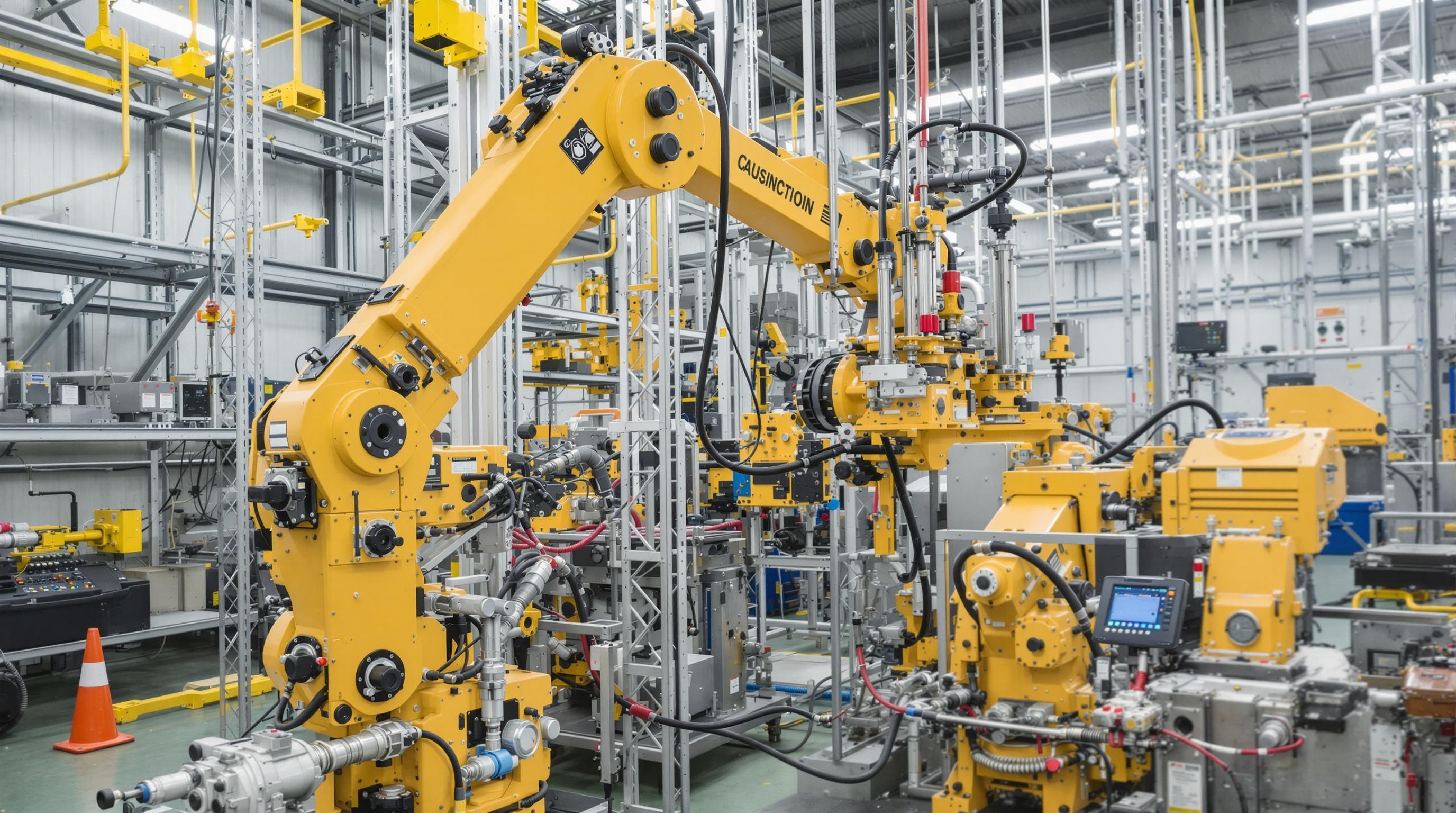Related Articles
- Unconventional Wisdom: Exploring Surprising Influencers Shaping Consumer Trends in 2023's Niche Ecosystems
- Beneath the Surface: Discovering the Unlikely Impact of Micro-Communities on 2023's Consumer Landscape
- Unexpected Catalysts: Exploring the Surprising Forces Influencing Subculture Trends in 2023
- Unmasking Influences: The Unlikely Narratives Behind Today's Obscure Market Trends and Consumer Choices
- The Paradox of Generosity: How Giving Can Lead to Unexpected Financial Gains in Competitive Markets
- The Unexpected Cost of Silence: How Communication Gaps Drain Resources in Organizations
11 Surprising Automation Techniques That Can Drastically Reduce Your Operating Costs and Boost Efficiency Today
11 Surprising Automation Techniques That Can Drastically Reduce Your Operating Costs and Boost Efficiency Today
11 Surprising Automation Techniques That Can Drastically Reduce Your Operating Costs and Boost Efficiency Today
1. Robotic Process Automation (RPA)
Robotic Process Automation (RPA) offers a transformative solution to mundane, repetitive tasks. By implementing software robots, businesses can automate data entry, invoice processing, and customer queries without human intervention. This not only speeds up tasks but also minimizes errors associated with manual processes.
The deployment of RPA can lead to a reduction in operational costs by as much as 30%. Industries that witness significant savings include finance, healthcare, and logistics. For instance, companies like UiPath have generated impressive ROI for clients through efficient automation of back-office functions.
In addition, RPA frees up employees to focus on more strategic, value-driven tasks, fostering a culture of innovation. By enhancing productivity and enabling workforce reallocation, organizations that adopt RPA can gain a competitive advantage in today’s fast-paced market.
2. Chatbots for Customer Service
Chatbots have revolutionized customer service by providing instant responses to customer inquiries. These automated tools can handle a myriad of tasks, from answering FAQs to processing orders. The capability of chatbots to operate 24/7 means that businesses can provide constant support without incurring additional staffing costs.
A study from Gartner predicts that by 2025, 75% of customer service interactions will be powered by AI chatbots. This shift not only results in reduced labor costs but also enhances customer satisfaction through immediate assistance. Organizations like Sephora and H&M already utilize chatbots to streamline customer interactions and improve service efficiency.
Furthermore, chatbots can collect valuable data on customer preferences, allowing businesses to tailor their services for better engagement. Such insights lead to enhanced marketing strategies and promote customer loyalty, further driving down costs related to customer acquisition.
3. Automated Marketing Campaigns
Automating marketing campaigns enables businesses to efficiently manage customer interactions across various channels. Email marketing platforms like Mailchimp and HubSpot facilitate targeted campaigns that nurture leads without manual oversight. Automation ensures timely delivery and segmentation, optimizing user engagement.
By implementing automated workflows, businesses can achieve a higher return on investment (ROI) on their marketing efforts while minimizing human errors. According to a report by Forrester, organizations that leverage automated marketing see better conversion rates, which can lead to a significant increase in sales over time.
This technique effectively reduces the resources needed for campaign management and allows marketing teams to dedicate time to strategic initiatives rather than repetitive tasks. In this way, automation not only drives efficiency but also fosters a culture of creativity within the business.
4. Inventory Management Systems
Advanced inventory management systems are key to streamlining supply chain operations and cutting costs. Automated inventory systems keep track of stock levels in real-time, helping businesses prevent overstocking and stockouts. This visibility can lead to improved order fulfillment and reduced waste.
Using systems such as TradeGecko and Cin7 can result in significant savings in inventory holding costs. According to a study by the Institute of Supply Chain Management, organizations that implement automated inventory solutions can achieve up to a 25% reduction in inventory costs.
Moreover, these systems often integrate with e-commerce and accounting platforms, providing a unified view of operations that enhances decision-making. Clear insights into inventory trends enable businesses to make data-driven decisions that optimize their supply chain further.
5. Employee Scheduling Tools
Employee scheduling tools can automate one of the most time-consuming tasks in human resources management. Platforms like When I Work and Deputy allow businesses to create efficient schedules quickly and easily. This automation reduces scheduling conflicts and ensures sufficient staffing levels at all times.
By streamlining scheduling processes, businesses can decrease labor costs and improve workforce productivity. According to the Workforce Institute, organizations that invest in scheduling automation can realize up to a 20% improvement in labor efficiency.
Additionally, these tools often come with features that allow employees to swap shifts or communicate availability, which enhances employee satisfaction. A happy workforce is often a more productive one, leading to further cost reductions and increased efficiency.
6. Document Management Systems
Document management systems (DMS) have become essential for organizations looking to improve workflow efficiency. By digitizing paper documents and automating document retrieval, businesses can save on printing and storage costs. DMS solutions also allow for better document security and compliance tracking.
According to AIIM, organizations that implement document management solutions report a 30% increase in employee productivity. This fostered productivity can lead to lowered costs related to both time and resources associated with managing paper documents.
Moreover, automated workflows related to document approvals can drastically reduce project timelines. By linking DMS with other software tools, companies can ensure seamless collaboration between departments, further improving operational efficiency.
7. Online Payment Processing
Automated online payment processing systems simplify transactions, allowing businesses to receive payments faster and with fewer manual steps. Solutions like Stripe and PayPal streamline invoicing and payment collection while providing customers with a user-friendly payment experience.
According to a study from McKinsey, companies that transition to digital payment methods can reduce the cost of processing payments by up to 50%. This significant reduction stems from decreased labor costs and fewer errors associated with manual payment handling.
Furthermore, automated reminders and confirmation emails ensure timely payments, which helps maintain healthy cash flow. By minimizing the time it takes to receive payments, businesses can reinvest with greater agility, further enhancing operational efficiency.
8. Supply Chain Automation
Supply chain automation enables organizations to monitor and manage the flow of goods with minimal human intervention. By integrating technologies such as IoT and AI, businesses can optimize logistics, track shipments, and manage supplier relationships with remarkable accuracy.
According to a report by McKinsey, companies that automate supply chain processes can achieve profit margins up to 20-25% higher than non-automated competitors. This underscores the importance of leveraging automation to drive cost savings and efficiency.
Additionally, automating procurement processes reduces the time to source materials, allowing businesses to respond to market demands swiftly. This responsiveness becomes crucial in today's fluctuating market, further solidifying the case for supply chain automation.
9. Predictive Maintenance
Predictive maintenance uses data analytics to predict equipment failures before they occur, allowing businesses to carry out maintenance only when it’s needed. This approach minimizes downtime and extends the lifespan of machinery, leading to substantial cost savings in maintenance and repairs.
According to a study by Deloitte, predictive maintenance can reduce maintenance costs by 20-30% while improving equipment availability. This drastic reduction is invaluable for industries such as manufacturing and logistics, where equipment uptime is directly linked to profitability.
Furthermore, predictive maintenance leads to a safer working environment by reducing the risk of equipment failure that could result in injuries. This provides an added incentive for companies looking to enhance both efficiency and workplace safety through automation.
10. Billing and Invoicing Automation
Billing and invoicing automation streamlines the financial processes within a business. By using software to automate invoice generation and billing reminders, companies can reduce errors and free up finance staff from manual tasks. This leads to a more efficient finance department overall.
Research from Zogby Analytics indicates that automated invoicing can reduce billing cycles by up to 20 days, thus improving cash flow. Faster invoicing translates into quicker payments, which is crucial for small businesses looking to maintain liquidity.
Moreover, automated billing can enhance customer satisfaction, as clients appreciate timely and accurate billing. By improving the customer experience, companies not only save costs but also promote repeat business and strengthen relationships.
11. Workflow Automation
Workflow automation encompasses a variety of processes, allowing businesses to create efficient workflows across different departments. Tools like Asana and Trello enable teams to automate routine tasks, track project progress, and improve collaboration without unnecessary manual oversight.
Utilizing workflow automation can improve business agility by ensuring that tasks are completed on time and with fewer errors. A report from Gartner suggests that companies leveraging workflow automation can reduce operational costs by as much as 40% while significantly improving team productivity.
In an environment where adapting quickly to market changes is critical, workflow automation enables organizations to react swiftly to challenges. By providing teams with the tools they need to work more effectively, businesses can enhance both efficiency and profitability.





